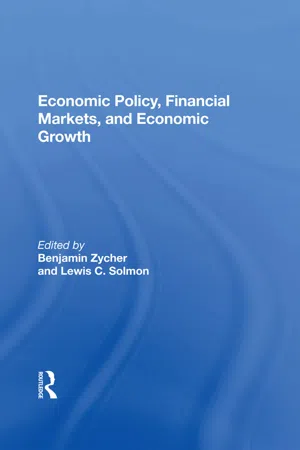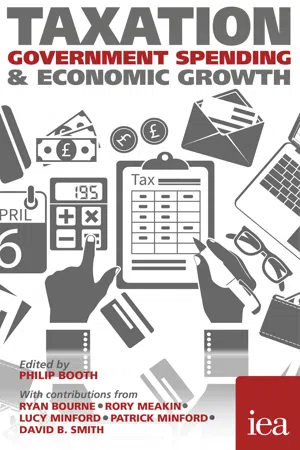Economics
Government Income and Expenditure
Government income and expenditure refers to the money that a government receives and spends. Government income typically comes from sources like taxes, fees, and borrowing, while government expenditure includes spending on public services, infrastructure, and social welfare programs. Balancing income and expenditure is crucial for maintaining a stable economy and providing essential services to citizens.
Written by Perlego with AI-assistance
Related key terms
6 Key excerpts on "Government Income and Expenditure"
- eBook - ePub
Macroeconomic Theory
A Dynamic General Equilibrium Approach - Second Edition
- Michael Wickens(Author)
- 2012(Publication Date)
- Princeton University Press(Publisher)
figure 5.1 , which plots government expenditures as a proportion of GDP for the United States and for the United Kingdom since 1901. Real government expenditures on goods and services and real social security benefits as a proportion of GDP have increased considerably over the last century. In 1901 they were only 2.3% of GDP for the United States and 13.5% for the United Kingdom. In most Western countries they increased from around 10–20% of GDP prior to World War I to around 40–50% after World War II. The wars themselves were the times of the greatest expansion in government expenditures. Since World War II, the shares of government expenditures in GDP have risen steadily and, apart from unemployment benefits, which vary countercyclically over the business cycle, they are not much affected by the business cycle. On average, the expenditures on goods and services and on transfers are roughly equal in size. Total government expenditures also include interest payments on government debt.Government revenues are primarily tax revenues: direct taxes on incomes and expenditure, social security taxes, and corporate taxes. The balance varies somewhat between countries, but for most developed countries direct taxes and social security taxes—which are in effect taxes on incomes—are about 60% of total tax revenue, consumption taxes are about 25%, and corporate taxes are about 10%. The average tax rate on incomes (including social security) is around 42%. Tax revenues tend to be more affected by the business cycle than expenditures. This is the main reason why government deficits tend to increase during a recession.As previously noted, governments can raise additional revenues through borrowing from the public or borrowing from the central bank, i.e., by printing money. The government simply extends its overdraft on its account with the central bank, which cashes checks issued to the public by the government.It is common in macroeconomics without microfoundations, such as Keynesian macroeconomics, to treat government expenditures as having no welfare benefits. They are included simply to allow fiscal policy to be included in the analysis and to allow the size of the fiscal multiplier to be calculated. In the standard Keynesian model this is the effect on GDP of a discretionary change in government expenditures. As this is tantamount to buying goods and services and then throwing them away—or, as Keynes himself noted, burying them— this is not a satisfactory formulation of fiscal policy. In our analysis we start by including government expenditures in the household’s utility function. We then discuss the issue of the optimal level of government expenditures. This is followed by an analysis of public finances: how best to pay for government expenditures and satisfy the government budget constraint. We also examine optimal tax policy, optimal debt, and the sustainability of fiscal deficits (the fiscal stance) in the longer term. At the end of the chapter we summarize our findings on the best way to manage fiscal policy. - eBook - ePub
Public Finance
An International Perspective
- Joshua E Greene(Author)
- 2011(Publication Date)
- WSPC(Publisher)
Government tax laws, expenditure programs, and regulation all impose costs, often substantial, on the private sector. These costs do not count as government expenditures. Yet they represent part of the “burden” of government on an economy. Government building codes impose additional costs on contractors, businesses, and homeowners, for example. Paying taxes and complying with tax regulations also involve substantial amounts of time and expense for firms and households. These amounts should be remembered when figuring the “true” cost of government.Finally, many expenditure programs contain hidden taxes, in the form of reducing benefits as income rises. In some countries, subsidy rates and benefit payments for certain programs decline as income rises. For example, in the United States, an “earnings test” causes social security benefits for those younger than “full retirement age” (the age at which benefits are no longer reduced for early retirement) to be reduced by US$1 for every US$2 in earnings. Before 2000, benefits were reduced by this amount for those aged 65 to 69; before 1983, it applied to those younger than 72.5III. Main Categories of Government ExpenditureAs noted in Chapter Four, the main components of government expenditure can be classified in two ways: economically, and by function. Under the 1986 Manual on Government Finance Statistics, which most countries still use, the economic classification of government expenditure identifies three broad types of outlays: current expenditure, capital expenditure, and net lending (which represents net outlays — loans minus the repayment of principal — for government lending programs that serve policy purposes). Current expenditure comprises outlays for wages and salaries (compensation of employees), purchases of other goods and services (non-wage outlays for operations and maintenance), interest payments, and subsidies and transfers. Military outlays are usually included in current expenditure, except for identified outlays for military bases. Capital expenditure comprises all outlays for long-term projects, such as infrastructure, and spending for military installations (but not weapons or armaments). The 2001 Government Finance Statistics Manual - Benjamin Zycher(Author)
- 2019(Publication Date)
- Routledge(Publisher)
Government Spending and TaxationPassage contains an image
Introduction
The consumption and reallocation of resources perhaps constitute the very essence of government, achieved in the main through its powers of taxation and spending. That such fiscal activity by the public sector yields both benefits and costs is beyond doubt, but the measurement of those effects remains difficult, despite much research effort over many years. This difficulty does not reduce the need for qualitative and quantitative analysis of the benefits and costs of fiscal activity, as government consumes and redirects a substantial proportion of national output in most of the world.But for market economies, in which prices are assumed to reflect the value and cost of resources, the value of government output in national accounts generally is measured as (or is assumed to be equal to) the cost of the inputs used by government; those costs usually do not reflect secondary but important effects of taxation and spending. If government is “too big”-that is, if aggregate wealth would be increased were some resources shifted away from government back to the private sector-then the national accounts are likely to overstate the value of government spending. And the secondary effects of fiscal activity imply that the government budget would understate the true economic cost of taxation and spending.Notwithstanding the existence of a vast literature on the demand and cost of public services, much work remains to be done in terms of both conceptual and empirical analysis of public sector spending and taxation, and attendant effects upon aggregate economic well-being. William A. Niskanen reports empirical findings on the effect of several types of fiscal activities upon three alternative measures of economic growth. He finds that government spending increases real GNP significantly, whereas taxes and deficit spending (i.e., future taxation) have significant negative effects. Interestingly, Niskanen finds that the economic benefits of nondefense spending not used for transfer payments-loosely, public sector nondefense investment-may be greater than the economic costs of the taxes and debt needed to finance the additional spending, at least as the benefits are measured in his econometric analysis. One possible problem with this finding is that some or much government investment could be undertaken by the private sector, and it is at least plausible that costs would fall. If that is true, it may suggest that the actual net effect of some government spending upon growth and productivity is negative, but not captured by the data.- eBook - ePub
- Arleen J Hoag, John H Hoag(Authors)
- 2006(Publication Date)
- WSPC(Publisher)
Chapter 25 ). If the deficit is too large, the budget may be adjusted either by raising taxes or lowering spending. Similarly, if the surplus is too large, expenditures may be increased or taxes lowered.Government expenditures have the same impact on the economy as consumer consumption or business investment. An increase in any one serves to speed up the economy; a reduction in any one serves to slow down the economy. In the three-sector economy, the aggregate demand relates C +1 + G and the price level, where G represents government spending. As government spending increases, so do aggregate demand and the equilibrium level of income; as government spending decreases, so do aggregate demand and the equilibrium level of income. Now aggregate demand is the total spending of the economy including government.Note that the business and consumer sectors cannot spend at will. Investment is dependent on the level of interest, and consumption is dependent on the level of income. This is not true of the government sector. Most government spending is independent of both the interest rate and income. Thus the interest rate and level of income do not keep the government from spending more. However, government too encounters opportunity cost, which will be discussed in Chapter 25 .Government spending can be used as an economic tool. An increase in government spending increases aggregate demand. If consumers, business, and government were each spending $100 and then government increases its spending by another $100, then aggregate demand will increase from $300 to $400. What the government purchases, or the reasons for its purchase, make no difference in the impact of its spending. Simply the fact that government has increased spending will increase total spending and therefore the level of aggregate demand. Similarly, a decrease in government spending will reduce the level of aggregate demand. - Philip Booth, Ryan Bourne, Rory Meakin, Lucy Minford, Patrick Minford, David B. Smith(Authors)
- 2016(Publication Date)
- London Publishing Partnership(Publisher)
In addition to Ricardian Equivalence effects, private capital formation also seems to be reduced by budget deficits, because of the uncertainties created with regard to future taxes and interest rates. This suggests that when spending is financed by deficits it will ultimately crowd out roughly the same volume of activity as if it is financed by taxes – though the effects of financing spending via taxes might come through less quickly. Indeed, in this context, it is conceivable that the present sluggish growth observable in so many Western economies reflects the supply-side hangover that followed the Keynesian-inspired public spending binge that was the politicians’ reaction to the financial crash.This analysis suggests that the tax burden ought really to be measured by looking at total government spending which is financed by taxes and borrowing (in effect, deferred taxes in most cases). The ratio of general government expenditure to national income is shown in Figure 2 .No institution can tax itselfThe second important truism, which follows from the previous analysis, is that the tax base is not total gross domestic product (GDP) but only the residual component of GDP after government spending has been subtracted – in other words, we should focus on the burden of government on the private sector. Individual arms of government pay taxes to other parts of government (e.g. local authorities pay VAT on their purchases). However, these transfers net out for government as a whole, even if this is not always apparent in the published statistics.Regrettably, the longer-term projections for tax receipts made by the Office for Budget Responsibility (OBR) appear to be largely driven by their predictions for money GDP. However, the public/private distinction is highly important when forecasting because the ratio of private to total GDP shows marked cyclical swings (see Figure 2 ). Some of the forecasting errors in the official predictions of government receipts from the OBR – and HM Treasury before them12- eBook - ePub
Economic Inequality and Poverty: International Perspectives
International Perspectives
- Lars Osberg(Author)
- 2017(Publication Date)
- Routledge(Publisher)
8 The Impact of Government Tax and Expenditure Programs on the Distribution of Income in the United StatesPatricia RugglesThe government of the United States, like most national governments, undertakes many activities that affect both the size and the distribution of the nation's income. Some of these activities are the result of policies that are explicitly designed to affect personal incomes—for example, welfare programs that are intended to alleviate poverty, or tax policies that impose higher rates on those with higher incomes. Other policies affect incomes more or less unintentionally, as a by-product of other goals. Examples of this type might include government purchases of goods and services (e.g., weapons systems) that increase the incomes of earners in specific industries or localities, or tax and regulatory policies that affect the returns to certain types of investment.In addition to the direct and indirect income effects outlined above, government policies also affect incomes if they result in changes in the performance of the economy as a whole. A period of high unemployment is likely to result in high poverty rates and generally greater income inequality, for example, while continuing high deficits may result in high real interest rates, which may in turn increase the relative return to capital, at least in the short run. Over the longer run, if spending for current consumption crowds out investment for the future, government policies may even affect the distribution of income across generations.Income distribution in the United States is also affected by the actions of the various state and local jurisdictions that run their own tax and expenditure programs in addition to those of the federal government. All but a handful of states now have their own income tax systems, for example, and most also impose sales and other taxes. Local jurisdictions typically have some sort of property tax, and may have other tax programs as well. On the expenditure side, states and localities contribute to cash transfer programs such as welfare and general assistance, and also contribute to many programs providing in-kind benefits such as hospitals and other medical care, education, and public housing.
Learn about this page
Index pages curate the most relevant extracts from our library of academic textbooks. They’ve been created using an in-house natural language model (NLM), each adding context and meaning to key research topics.





